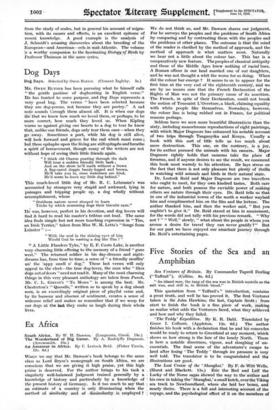Ex Africa
WHEN we say that Mr. Dawson's book belongs, to the same class as Lord Bryce's monograph on South Africa, we are conscious that we are giving- it high praise, yet this high praise is deserved. For the author brings to his task a singularly well-balanced judgment trained generally- by a knowledge of history and particularly by a knowledge of the present history of Germany. Is it too much to say that an. estimate of a country is only illuminating when the method of, similarity and, -of dissimilarity is_ _employed ? We do not think so, and Mr. Dawson shares our judgment. For he surveys the peoples and the problems of South Africa ,by comparing and by contrasting them with the peoples and the problems of other places. The outcome is that the mind of the reader is clarified by the method of approach, and the method of approach is what matters most. Naturally we hear not a little about the colour bar. This bar is a comparatively new feature. The peoples of classical antiquity and those of the Middle Ages knew nothing of racial bars. A Roman officer in our land married one of our daughters, and he was not thought a whit the worse for so doing. "-When did the colour bar emerge? It seems to us to appear for the first time at the very end of the eighteenth centurk, and we are by no means sure that the French Declaration of the Rights of Man was not the -primary cause of its assertion. The French, in spite of their Declaration, could- not brook the notion of Toussaint L'Overture, a black; claiming equality with white people like themselves. Nowadays, however, the colour line is being rubbed out in France, for political
reasons perhaps. -
Seldom have we seen more beautiful illustrations than the sixty, including monochrome reproductions of eight paintings, with which Major Dugmore has enhanced his notable account of two trips through Tanganyika and Kenya. Usually a book with this sort of title tells us too much about mere destruction. This one, on the contrary, is a joy, for its author pursued the animals with his camera. -Major Dugmore rightly holds that cameras take the place of firearms, and if anyone desires to see the result, we eommend this book most warmly to his attention. He lays stress on the fact that there is not only pleasure but plenty of thrills in watching wild animals and birds in their natural State.
Dr. Lestock Reid and Major Dugmore are two 'travellers who ought to meet, for they own kindred tastes. Both care for nature, and both possess the enviable power of making others see nature through their eyes. Dr- Reid fells us that in one of the industrial towns of the north a worker waylaid him and complimented him on the film and the lecture. The author thanked him, and then the worker said, " But you oughtn't to give it." Dr. Reid stared at him in amazement, for the words did not tally with his previous remark. "Why not?" "Well," slowly, "what about the people in -whom you arouse a desire for travel they can never gratify?" - But for our part we have enjoyed our armchair journey through Dr. Reid's entertaining pages.






















































 Previous page
Previous page